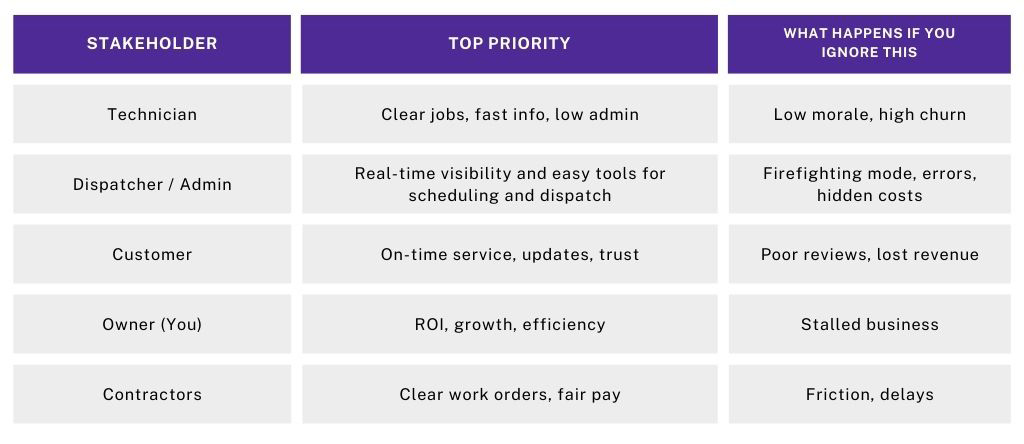Running a Field Service Management (FSM) business goes beyond scheduling jobs and completing them. It’s about balancing the needs of everyone involved. From your technicians in the field to your customers, each group has unique priorities that must be met.
When you align your operations with the needs of all your stakeholders, you create a smoother, more efficient business. This leads to faster service, happier customers, and a more profitable operation, driving growth and customer loyalty.
It’s simple: happy stakeholders equal a thriving field service business.
In this article, you will learn how to identify your stakeholder needs, what are some common conflicts that arise and how to resolve them, and which measures you need to put in place to support your stakeholders and deliver true value.
Who Are Your Stakeholders?
When it comes to stakeholder management in field service management, everyone, whether internal or external has unique priorities and plays a vital role in the overall operation.
Let’s take a closer look at who these stakeholders are and what they need to thrive.
- Technicians: They’re the hands-on experts who represent your business in the field. Technicians need the right tools, clear job details, and support to deliver quality service and keep customers happy.
- Admin/Dispatchers: The behind-the-scenes jugglers who keep everything organized. Your admin/dispatchers coordinate schedules, manage resources, ensure the right technician gets to the right job on time, follows up on late payments and more!
- Customers: The lifeblood of your business. Without them, there is no FSM. Customers want timely, reliable service and transparent communication—your reputation depends on their satisfaction.
- The Owner: As the business owner, you’re focused on efficiency, profitability, and growth. You need data to drive smart decisions and ensure your operation runs smoothly while keeping costs in check.
- Contractors/Partners: External help you rely on to scale your service. Contractors and partners need clear work orders, fair compensation, and a transparent relationship to help you meet growing demand.
What Does Each Stakeholder Need to Succeed?
To run a successful FSM business, you need to ensure each stakeholder has what they need to thrive. Let’s break down what each group needs to perform at their best:
- Technicians: Clear job details, easy access to the tools they need, and mobile-friendly solutions that allow them to work efficiently. When techs have everything they need at their fingertips whether it’s job instructions, inventory, or customer history—they can focus on delivering quality work.
- Dispatchers & Admin: Real-time updates, an easy-to-use scheduling platform, and the ability to manage resources efficiently. With the right tools, dispatchers can make quick adjustments, avoid scheduling conflicts, and keep technicians moving in the right direction. For admin teams, reliable systems that integrate seamlessly with other tools are key to keeping things running smoothly behind the scenes.
- Customers: Timely, transparent communication and high-quality service. Customers want to be kept in the loop whether it’s about arrival times, service updates, or completion statuses. When they know what’s happening and when, it builds trust and keeps them coming back.
- The Owner: Actionable data that helps you make smart decisions and optimize operations. Whether it’s monitoring key performance indicators (KPIs), tracking job profitability, or analyzing technician performance, you need access to real-time insights to drive efficiency and growth.
- Contractors/Partners: Clear work instructions, fair compensation, and timely communication. When you’re working with external partners, they need clarity on their roles and expectations. Transparent processes and good relationships help keep everything on track.
Stakeholder management in field service management becomes simpler when everyone has the tools, information, and support they need to ensure better service delivery.
Aligning Your Field Service Processes with Stakeholder Needs

First impressions matter, and these days, they often happen before you even arrive at the job.
A bit of personalisation before the service starts can make your business look more professional, organised, and trustworthy.
Send Booking Confirmations That Feel Human
Instead of a boring “Job booked” email, add a personal touch.
Use the customer’s name, the type of job, and the date/time. For example:
“Hi Emma, your plumbing appointment is confirmed for Tuesday at 10:00 AM. We’ve got you down for a kitchen tap replacement. Looking forward to seeing you!”
This feels more thoughtful and helps avoid any confusion.
Share Arrival Windows and Real-Time Updates
People appreciate knowing when to expect you. If you use job management software, you can send a message like:
“Your technician, Mike, is on his way and should arrive between 2:00–2:30 PM.”
Even better? Include live tracking if your software allows it. Platforms like i4T Business come with an integrated service request consumer app to do exactly this. You can track your work progress and stay in the loop from start to finish.
Include Technician Bios and Past Job Info
A short intro to the technician builds trust, especially if the customer hasn’t met them before. Something simple like:
“Mike has 10+ years of experience and worked on your heating system last winter. He’s got all the job info ready to go.”
This makes your business feel organised, safe, and professional.
Use Smart Templates with a Personal Touch
Your job management software should let you set up automatic texts and emails with personalised fields (like customer name, job type, time, tech name, etc.). This means you can send friendly, tailored messages without writing them from scratch every time.
Here’s a quick example of a great SMS template:
“Hi [CustomerName], your [JobType] is booked for [Date] at [Time]. [TechnicianName] will be there and is looking forward to helping!”
The Conflicts: Where Things Can Go Wrong
In any FSM operation, there are bound to be conflicting priorities.
Balancing speed, efficiency, and customer satisfaction can be tricky, and if not managed properly, these conflicts can lead to mistakes and frustration.
Here are some common areas where things can go wrong:
- Speed vs. Accuracy: In the rush to meet tight schedules, technicians and dispatchers may prioritize speed over accuracy. Fast dispatch and quick job turnarounds are important, but if speed is the only focus, it can lead to errors missed details, incorrect parts, or incomplete jobs. This can result in rework, increased costs, and unhappy customers. It’s crucial to ensure that quick service doesn’t come at the expense of quality.
- Customer Updates vs. Dispatch Pressure: Customers expect real-time updates on job status, especially for arrival times and progress reports. However, dispatchers are already under pressure to manage schedules, allocate resources, and handle unexpected issues. Constantly providing updates to customers can overwhelm dispatchers and distract them from the bigger task of keeping everything running smoothly. Without the right systems in place, balancing customer expectations with the needs of dispatch can become a stressful juggling act.
- Efficiency vs. Human Touch: As businesses scale, it’s tempting to automate processes to increase efficiency. However, too much automation like impersonal automated messages or over-reliance on systems can make your service feel robotic and disconnected from the human touch that customers value. The personal connection between your field techs and customers is often what builds trust and loyalty. Striking the right balance between automation and personal interaction is key to keeping that connection intact while improving operational efficiency.
How to Make Everyone’s Job Easier
Running an efficient FSM operation isn’t just about providing your team with the right tools—it’s also about understanding their needs and streamlining workflows.
Here’s how you can make life easier for everyone involved:
Get Team Feedback
Your technicians and dispatchers are on the frontlines, so involve them in decisions about how to improve workflows. When you ask for feedback, you’re showing them that their opinions matter, and you’ll gain valuable insights into the challenges they face every day. Whether it’s simplifying job orders, adjusting schedules, or improving communication, your team knows best where improvements can be made. Listening to them will lead to smoother processes and better results.
Create Custom Processes
One-size-fits-all solutions don’t work when it comes to FSM. Tailor your systems to meet the unique needs of each role. Technicians need mobile tools that allow them to access job details, update statuses, and even capture customer signatures on the go. Dispatchers need easy-to-use scheduling tools that provide real-time updates and job visibility to optimize resource allocation. Customers, meanwhile, need timely updates about job status, arrival times, and completion details. Customizing processes to meet these specific needs helps keep everyone on track and enhances overall service delivery.
Use Simple, Effective Tools
Invest in tools that are intuitive and easy to use. Complex systems with a steep learning curve will only slow things down. Look for software and tools that work for your team, not the other way around. Mobile apps for technicians, user-friendly dashboards for dispatchers, and automated updates for customers can all save time and effort. When your team has the right tools, they can focus on what they do best whether it’s completing jobs efficiently or delivering exceptional customer service without getting bogged down by unnecessary complications.
Key Features to Support Your Team
To keep your FSM operation running smoothly, you need tools that empower every stakeholder to do their job effectively.
Here are some key features that can support your team and streamline your processes:
Mobile apps are a game-changer for technicians
Technicians are in the field, and they need easy access to job details, customer history, and the ability to update job statuses on the go. Mobile apps can streamline this process, allowing techs to update their progress, mark jobs as complete, and even capture photos or signatures all from their smartphones. With all the information they need at their fingertips, technicians can work more efficiently, reducing errors and improving first-time fix rates.
Real-time dashboards are essential for dispatchers
These dashboards provide a clear view of job statuses, technician locations, and job progress helping dispatchers manage schedules with ease. With real-time data, they can quickly identify issues, make adjustments to the schedule, and assign the right technician to the right job. This reduces downtime, minimizes delays, and ensures customer satisfaction by having the right technician in the right place at the right time.
Keeping customers informed is key to building trust
Automated notifications can be used to provide customers with real-time updates about job status, estimated arrival times, and completion notifications. Additionally, a self-service portal allows customers to track the progress of their jobs, reschedule appointments, and view service history giving them more control over their experience and reducing the number of inquiries your team needs to handle.
Business owners need clear metrics to monitor performance and profitability
Dashboards that consolidate data on job completion rates, technician productivity, and financial performance allow you to make informed decisions. Whether you’re looking at resource utilization, customer satisfaction, or job profitability, these dashboards provide a snapshot of your business in real time, helping you identify areas for improvement and growth.
By implementing these key features, you’re not only making your team’s job easier, but also improving operational efficiency and customer satisfaction.
It’s all about giving each stakeholder the tools they need to succeed.
Measuring Success: KPIs That Matter
To ensure your FSM business is running at its best, you need to measure success with the right Key Performance Indicators (KPIs). These metrics help you track progress, identify areas for improvement, and keep every part of your operation aligned. Here are the KPIs that matter most for each stakeholder:
Customer Satisfaction and Loyalty
Satisfaction Scores (CSAT): Customer feedback is invaluable. Regularly collecting satisfaction scores after each service gives you insight into how well your team is meeting customer expectations. High satisfaction scores mean customers are happy with the service, increasing the likelihood of repeat business.
Repeat Business: One of the best indicators of customer satisfaction is their return business. Tracking repeat customers shows you’re not just meeting expectations but also building trust and loyalty. Happy customers are more likely to refer you to others, creating a cycle of growth.
Field Team Efficiency
Productivity: Technicians are the backbone of your operation, and measuring their productivity helps ensure they’re working efficiently. Metrics like the number of jobs completed per day or time spent on each job give you insights into technician performance.
First-Time Fix Rates (FTFR): The first-time fix rate measures how often technicians are able to resolve a customer issue on their first visit. A higher FTFR indicates that your technicians are skilled, prepared, and equipped to handle jobs effectively, which directly impacts customer satisfaction.
Service Coordination Success
Job Completion Times: Dispatchers are responsible for ensuring jobs are completed on time. Measuring job completion times helps you identify bottlenecks, inefficiencies, or areas for improvement in scheduling. The quicker you can resolve jobs, the more profitable your operation will be.
Error Rates: Dispatchers need to ensure jobs are scheduled and assigned correctly. Tracking error rates whether it’s double-booking, missed appointments, or incorrect job assignments—helps you pinpoint areas that require attention and reduce costly mistakes.
Business Growth and Profitability
Return on Investment (ROI): As the owner, you need to track your ROI to ensure your business is profitable. This involves comparing the costs of service delivery with the revenue generated. A healthy ROI means you’re investing resources effectively and seeing returns.
Job Profitability: Monitoring how much profit you’re making on each job helps you understand the financial health of your business. By tracking costs like labor, materials, and travel time, you can adjust your pricing and processes to improve profitability.
Team Performance: The performance of your technicians, dispatchers, and support staff affects your overall business success. Metrics such as employee satisfaction, retention rates, and individual productivity can help you assess whether your team is performing at its best and where further development is needed.
Tracking the right KPIs for each stakeholder in your Field Service Business allows you to optimize your operations, improve service quality, and drive growth.
By consistently measuring and adjusting based on these key metrics, you’ll keep your FSM business on the path to success.
Building a Culture That Puts Stakeholders First
A successful FSM business is all about creating an environment where every stakeholder feels valued and equipped to thrive. When they succeed, your business succeeds.
This could mean empowering your team with the tools and training they need to succeed. This also means regular check-ins and updates between you, your team and your customers to foster trust and collaboration. Finally, your stakeholders’ needs will evolve, so regularly assess processes through feedback and adapt to ensure you’re always meeting those needs effectively.
Over to you
Building and maintaining a successful FSM business starts with understanding and meeting the needs of your stakeholders f rom technicians and dispatchers to customers and partners.
By focusing on clear communication, streamlined processes, and the right tools, you can create a thriving, efficient operation that drives growth and customer loyalty.
If you’re ready to take your business to the next level, i4T Business Field Service Management Software is here to help. With powerful features designed to support every part of your operation, delivering value to all your stakeholders across all touchpoints.
Try i4T Business FSM Software today and experience the difference for yourself.
FAQ
FSM involves managing and optimizing the delivery of services at customer locations, including scheduling, dispatching, tracking, and reporting on service activities.
Effective stakeholder management ensures that the needs of your technicians, dispatchers, customers, and other team members are met, leading to improved efficiency, customer satisfaction, and business growth.
Tools like FSM software streamline processes, improve communication, and provide real-time updates, making it easier to meet the needs of all stakeholders and improve operational efficiency.
Key performance indicators (KPIs) like customer satisfaction, first-time fix rates, job completion times, and profitability help measure success and identify areas for improvement.
.
i4T Business FSM Software provides tools for scheduling, real-time updates, mobile access for technicians, and customer communication helping your team work smarter, not harder.
Hot off the press!

Field Service Management sector operates, the i4TGlobal Team loves to share industry insights to help streamline your business processes and generate new leads. We are driven by innovation and are passionate about delivering solutions that are transparent, compliant, efficient and safe for all stakeholders and across all touch points.
Recent articles that may interest you as well..




